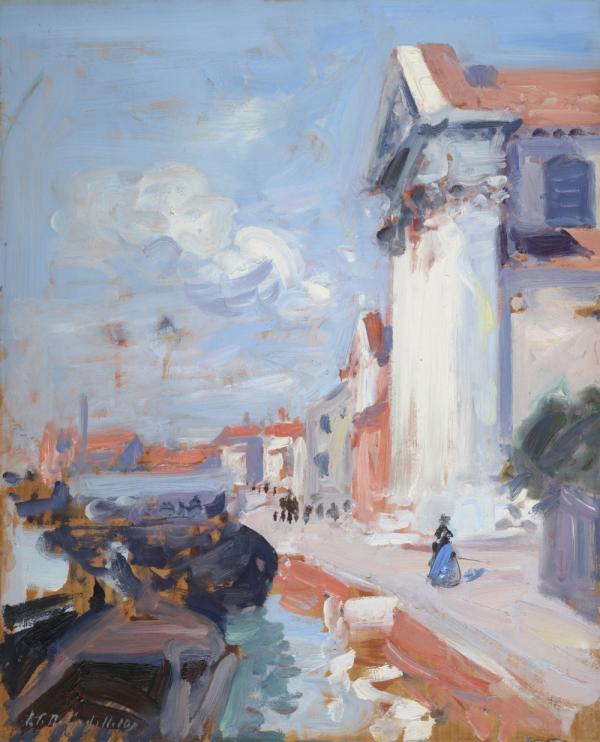The anonymous gift in 2022 of The Rose and the Lacquer Screen by the Scottish Colourist FCB Cadell (1883-1937) is celebrated by Alice Strang, former senior curator of Modern and Contemporary Art at the National Galleries of Scotland and curator of the exhibition from 2011-2012, The Scottish Colourist Series: FCB Cadell.

Some one hundred years after it was made, FCB Cadell’s The Rose and the Lacquer Screen still has the power to stop a viewer in their tracks. ‘Bunty’, as Cadell was affectionately nicknamed, was the youngest of the four artists commonly known as the Scottish Colourists along with J. D. Fergusson, G. L. Hunter and S. J. Peploe. He painted The Rose and the Lacquer Screen in the early 1920s when he was at the height of his creative powers.
In 1920 Cadell moved to 6 Ainslie Place in Edinburgh’s Georgian New Town, about twenty minutes’ walk from the current location of the Scottish National Gallery of Modern Art. His new home was magnificent, set over three principal floors, with two basement levels and an attic. He painted the front door bright blue to annoy his neighbours and took great trouble over the stylish decoration of the house’s interiors.
Walls were painted lilac, whilst floorboards were painted black and polished to a gleaming sheen. Furniture was kept to a minimum, including the distinctive Chinese lacquered screen seen in the new acquisition. Within the painting’s tightly-cropped composition, the screen’s fields of gold and black provide a striking background, whilst the warriors at the upper right suggest a dramatic narrative.
Cadell’s rooms were dressed with fine china, silver and glassware, joined by glamorous props, such as discarded opera cloaks, top hats and black fans. Cadell realised the head of the single stem flower in the mid-ground of The Rose and the Lacquer Screen by way of textured brushstrokes, which contrast with the flatness of its pure green leaves. The rendering of the view through the water in the vase is exceptionally skilful. The black diagonals of the screen lead to the beribboned, closed fan in the foreground, which contrasts with the brilliant blue of the surface on which the still life objects have been placed. An enigmatic gathering of lightly-coloured material at the lower left corner completes the bold and striking image.
The tight handling, brilliant palette and suppression of volume in works such as The Rose and the Lacquer Screen and The Blue Fan, of about 1922, embody the Art Deco style before the exhibition from which that term was derived was held in 1925. They are remarkable within Cadell’s practice and within British art of the period.
Similar changes from his looser, cooler pre-war work could be seen in Cadell’s contemporary figurative images, such as Portrait of a Lady in Black of about 1921. This depicts his favourite model, the Ainslie Place resident Bethia Hamilton Don Wauchope (1854-1944).
Cadell’s new paintings proved to be controversial. Lady Constance Emmott complained in The Scotsman’s letter page of 24 January 1920 about their ‘flagrant vulgarity and insolent disregard of draughtsmanship’. In contrast, the art critic of the Glasgow Herald praised the ‘undeniable artistry’ of his work shown at the Leicester Galleries in London in 1923, in an exhibition shared with Peploe and Hunter.
As the 1920s progressed, Cadell’s practice developed away from the daring innovation of the start of the decade to images suffused with a calm dignity. However, due to a decline in the art market coupled with a lavish lifestyle, Cadell had to leave 6 Ainslie Place in 1931.
Cadell was elected to the Royal Scottish Academy and the Royal Scottish Society of Painters in Watercolours in the 1930s, and was thus well established as an artist. However, he maintained his entry in Who's Who which listed his recreation as ‘Bed and Billiards’! He continuously lived beyond his means and died in 1937, with an uncashed cheque for £50 from the Alexander Nasmyth Fund for Decayed Scottish Artists amongst his possessions. He is buried in the Dean Cemetery next door to Modern Two.
Blog by Alice Strang.



